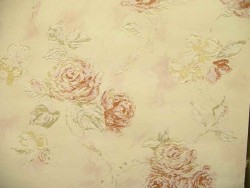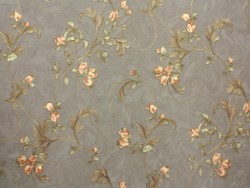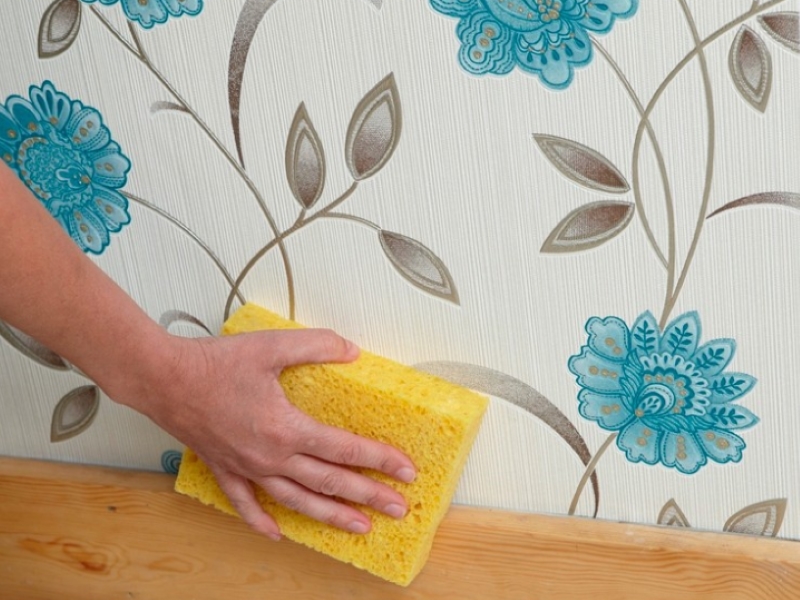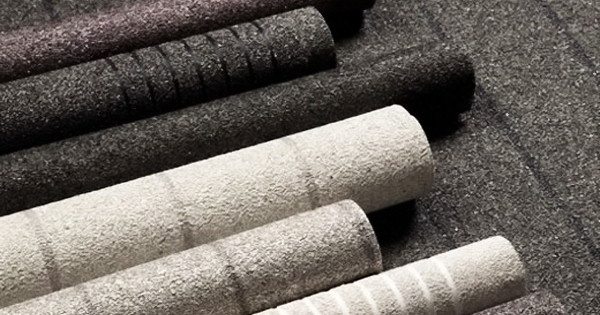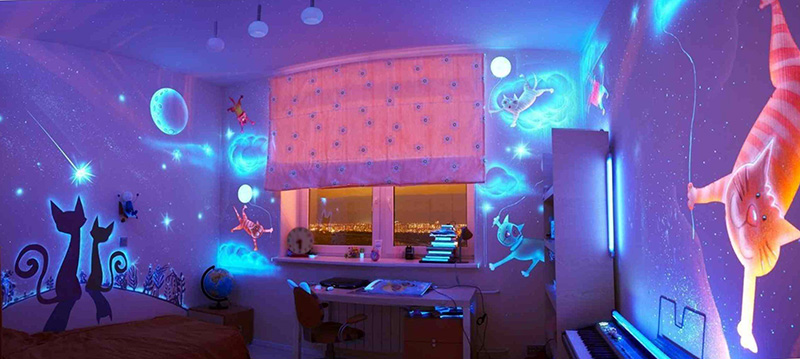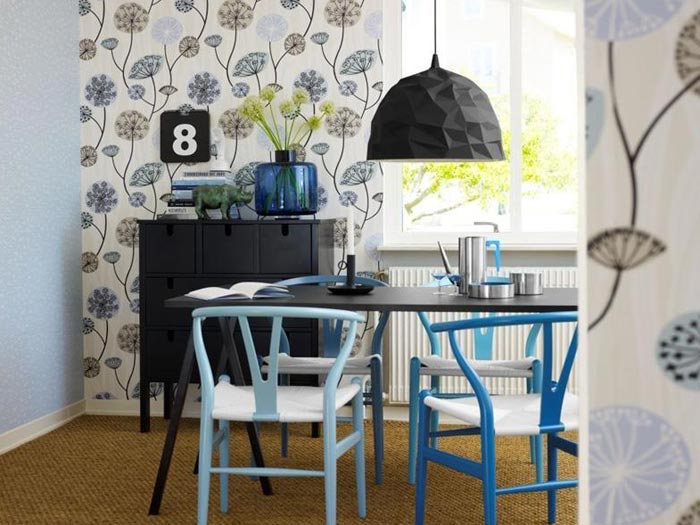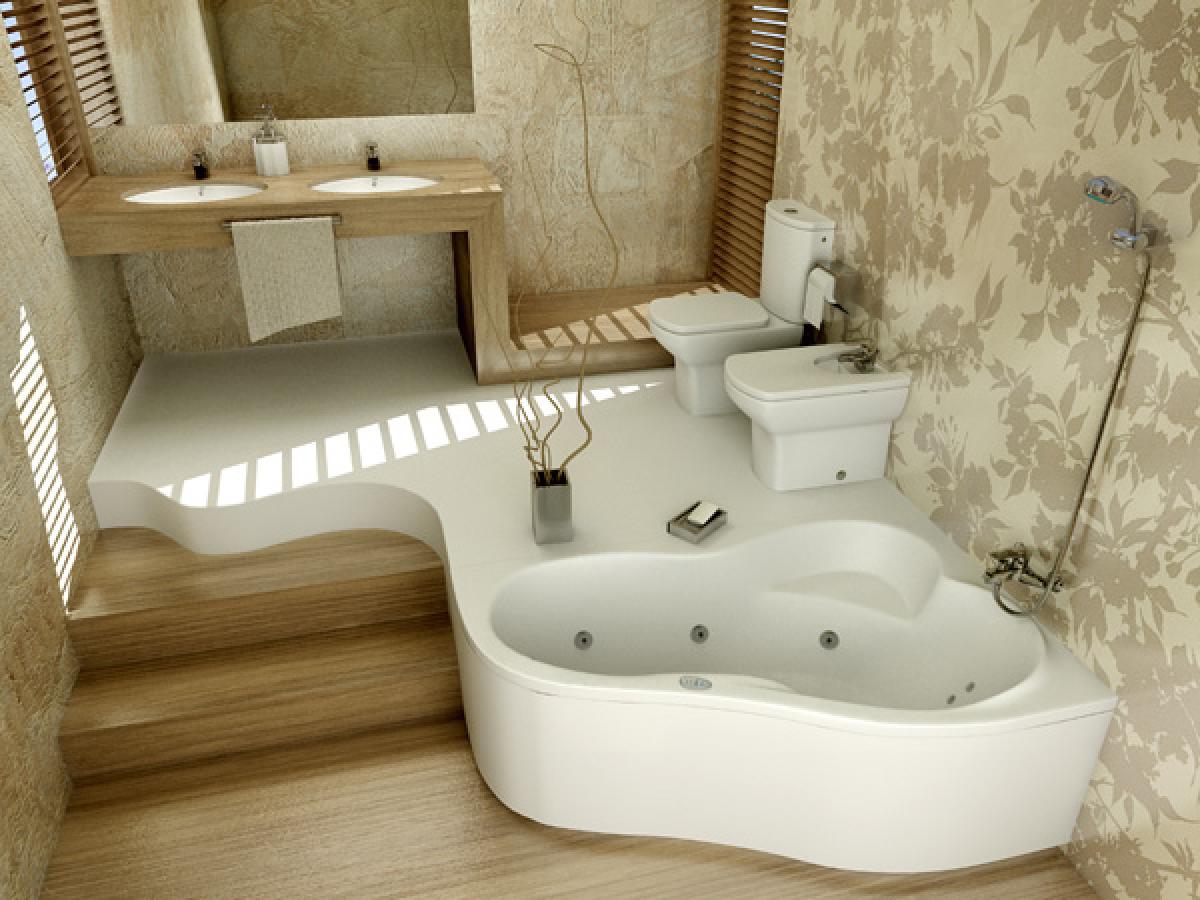Acrylic wallpaper: benefits, choice, sticking
Acrylic wallpaper is a wear-resistant and inexpensive coating that can withstand wet cleaning. It is these qualities that allow them to compete in the modern market of wallpaperrepresented by a huge amount of materials. Since acrylic wallpaper is a relatively new material, not everyone knows about it yet, and some confuse it with vinyl wallpaper. What are acrylic wallpapers, what are their advantages and features of gluing?
What is acrylic wallpaper?
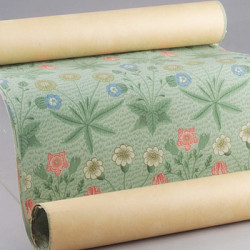 Acrylic Wallpaper consist of two layers: the first is paper, the second is foamed acrylic. The latter is applied not in a continuous layer, as is the case with the vinyl analogue, but in a dot, which allows you to get a relief pattern and a breathing surface. Layer foamed acrylic is about 2 mm. For comparison, on a vinyl wallpaper, the outer layer is 4 mm, which explains some of the differences in materials. A thinner coating layer means less weight, but also less wear resistance.
Acrylic Wallpaper consist of two layers: the first is paper, the second is foamed acrylic. The latter is applied not in a continuous layer, as is the case with the vinyl analogue, but in a dot, which allows you to get a relief pattern and a breathing surface. Layer foamed acrylic is about 2 mm. For comparison, on a vinyl wallpaper, the outer layer is 4 mm, which explains some of the differences in materials. A thinner coating layer means less weight, but also less wear resistance.
By the name "acrylic" is meant a group of polymers based on synthetic resins that foam beautifully and hold their shape.
Advantages and disadvantages of acrylic wallpaper
Based on the structure of the material, we can judge its key properties. Among the advantages it is worth highlighting the following qualities:
- high wear resistance;
- the material withstands mechanical damage, therefore it can be used in apartments where children and animals live;
- acrylic wallpaper can be washed, so the appearance will remain impeccable for a long time. You can wash it only with a slightly damp soft cloth and without the use of detergents, but it is also not bad;
 low cost. If you compare acrylic wallpaper with a direct competitor, vinyl wallpaper, they are somewhat cheaper;
low cost. If you compare acrylic wallpaper with a direct competitor, vinyl wallpaper, they are somewhat cheaper;- acrylic wallpaper breathe, which allows you to use them not only in hallways, like other washable wallpapers, but also in living rooms or even bedrooms;
- mold or fungus will not develop in acrylic wallpaper;
- thanks a large selection of colors and embossed surface Acrylic wallpapers can be used in almost any room and match many interior styles. Moreover, the relief allows you to hide some of the imperfections of the walls, but this is not about pits and cracks.
The disadvantages of the coating are not so many - they can be found if compared with other types of wallpaper and find fault. Due to the small thickness of the outer layer, the coating wears out faster, but this is relative, because the service life of the material is 10 years or more, depending on operating and maintenance conditions. Among the minuses are also often called the inability to wash acrylic wallpapers with detergents, but this does not interfere with the use of water to remove contaminants.
How to choose acrylic wallpaper?
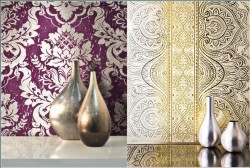 The material for all manufacturers is made by a similar technology: the base is always paper, the spraying is acrylic. This simplifies the choice, because you do not have to understand the intricacies of different technologies. In addition, today on sale appear non-woven acrylic wallpaperThey are part of the expensive collections of European manufacturers. Such material is characterized by increased wear resistance and durability.
The material for all manufacturers is made by a similar technology: the base is always paper, the spraying is acrylic. This simplifies the choice, because you do not have to understand the intricacies of different technologies. In addition, today on sale appear non-woven acrylic wallpaperThey are part of the expensive collections of European manufacturers. Such material is characterized by increased wear resistance and durability.
When buying material, it is better to pay attention to the parameters of the rolls. The length is usually 10.5 m and width ranges from 0.5 to 0.9 m. If the room is small, it will be more convenient to work with narrower wallpapers, and there will be much less trimmings.When it comes to spacious rooms, it is appropriate to use the widest possible material: this will allow you to quickly cope with the installation and reduce the number of joints.
Acrylic Wallpaper Price varies widely and depends on the name of the manufacturer, country of manufacture, relief, pattern, year of collection and some other factors. In this regard, everyone should sensibly evaluate their own budget. Experts recommend not chasing the most expensive wallpaper from import companies, but trust the choice to the manufacturer with a proven name, and it doesn’t matter if it’s domestic or foreign.
The main thing that you need to decide when choosing acrylic wallpaper is what will the design be. Firstly, it is necessary to take into account the size of the room, its style, orientation relative to the cardinal points, the color of furniture and textiles, and secondly, from the variety that the construction market offers, choose the right option. The task is not an easy one, but some useful tips will help you deal with this problem:
 light shades visually expand the room and are a universal solution for most apartments in typical high-rise buildings. Bright colors and large drawings also conceal the space, so owners of small rooms should better refuse them. In this case, it is better to use pastel and delicate shades with medium-sized drawings;
light shades visually expand the room and are a universal solution for most apartments in typical high-rise buildings. Bright colors and large drawings also conceal the space, so owners of small rooms should better refuse them. In this case, it is better to use pastel and delicate shades with medium-sized drawings;- compensate lack of lighting You can use wallpaper in warm colors: peach, yellow, coral, apricot. If the room is southern and the sunlight in it, on the contrary, is too much, then it is better to stop the choice in cold tones: light green, blue, light blue;
- you can not stop only on the wallpaper, because two types of material can be combined with each other. Usually choose plain wallpaper and with a pattern in the same tonality, but it is possible a combination of different colors, different ornaments on the background of the same color, etc. Different wallpapers can be alternated, used for one of the walls, or split the wall horizontally. There are a lot of combinations, and the result is an interesting interior;
- Wallpaper does not have to be chosen to match the tone of the furniture - it’s already in the past, but all the interior items in the room should be in harmony in color and pattern.
When buying acrylic wallpaper, pay attention to all rolls were from the same batch. So there are more guarantees that the material will not differ in shade. Packaging of products must be holistic and durable, the presence of certificates of quality and safety, as well as instructions for sticking is strictly necessary.
Acrylic wallpapers are great for rooms such as living room or bedroomas the material “breathes”. Will be appropriate such wallpaper in the hallwaythat doesn’t go straight to the street, but for kitchenswhere they are constantly and actively preparing something, and for bathtubs Acrylic wallpaper is not suitable.
How to stick acrylic wallpaper?
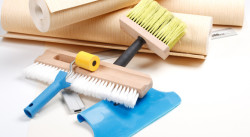 Acrylic wallpaper stick no harder than paper or vinylbut still some subtleties should be considered. Butt assembly, but some talk about the possibility of gluing them with an overlap, if the drawing is such that the joining places of the two canvases will not be very noticeable.
Acrylic wallpaper stick no harder than paper or vinylbut still some subtleties should be considered. Butt assembly, but some talk about the possibility of gluing them with an overlap, if the drawing is such that the joining places of the two canvases will not be very noticeable.
Although acrylic wallpapers can hide some wall defects, large cracks and bumps need to be leveled. Of course, if on the walls there are remnants of another finish, then before starting work it is necessary to get rid of it. Putty will be necessary for leveling, and if the surface is far from ideal, then it is better use plaster. Another option is align the walls drywall, but this method is relevant only for walls that are too damaged and provided that there is enough space in the room.
 Mandatory after alignment primed wall surface. You need to choose a composition that is suitable for the base material: concrete, brick, drywall etc. In extreme cases, you can breed wallpaper glue and the resulting solution to process the walls.
Mandatory after alignment primed wall surface. You need to choose a composition that is suitable for the base material: concrete, brick, drywall etc. In extreme cases, you can breed wallpaper glue and the resulting solution to process the walls.
After all this, not bad mark the walls to facilitate installation. Since sticking is usually started from the corner near the window, then a distance equal to the width of the wallpaper is laid off from it. A strictly vertical line is drawn at the mark, and the necessary distance is again laid off from it. You can do without this stage, but if a person who is not very experienced in this business works, then this markup will help to achieve a more accurate result.
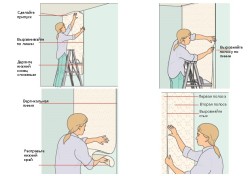 Now it's up to cutting the wallpaper itself. If they are monophonic, then there will be a minimum of problems. It is enough to know the height of the walls and add 4-5 cm to it for allowances. If there is a picture on the canvases, then it must be correctly combined: the manufacturer indicates how many centimeters will be needed to combine the picture. The consumption of such wallpaper will be much higher. For a more accurate cutting, it is desirable to measure the height of the walls in several places to make sure that it is the same everywhere, otherwise you need to take into account the errors when cutting wallpaper.
Now it's up to cutting the wallpaper itself. If they are monophonic, then there will be a minimum of problems. It is enough to know the height of the walls and add 4-5 cm to it for allowances. If there is a picture on the canvases, then it must be correctly combined: the manufacturer indicates how many centimeters will be needed to combine the picture. The consumption of such wallpaper will be much higher. For a more accurate cutting, it is desirable to measure the height of the walls in several places to make sure that it is the same everywhere, otherwise you need to take into account the errors when cutting wallpaper.
Adhesive for acrylic wallpaper cook according to the instructions to it. The process is simple and, as a rule, consists in adding a specific amount of water to the powder and thoroughly mixing. When the glue is ready, its applied to the canvas, which is carefully applied to the wall and pressed from top to bottom. Since acrylic wallpapers are elastic, they can be slightly shifted during installation. Air from under the material is removed using a roller, which smooths the surface from the center to the edges. It is better to carry out installation together.
After the wallpaper is pasted, they are left to dry for a day or two, and in the room it is necessary to ensure the absence of drafts and the temperature at the level of 18-220FROM.
In conclusion
Acrylic wallpaper is a great alternative to vinyl, because with similar performance this material is able to pass air. The assortment will allow you to choose the material suitable for any interior style, and installation should not cause any special difficulties if you correctly mark the wall in advance, cut the wallpaper, work carefully and adhere to optimal environmental conditions.

